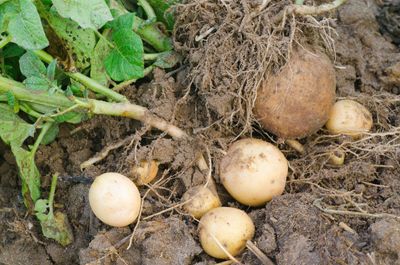What are Determinate Potatoes?
Determinate potatoes are varieties with tubers that grow in just one layer. For this reason, the plants do not require mounding of the soil around them. They produce early, in about 70 to 90 days. Sow determinate potatoes in loose soil to a depth of about 4 inches (10 cm.). Use mulch to prevent weed growth and to prevent the tubers from being exposed to the sun, which will turn the potatoes green. Examples of determinate potatoes are Yukon Gold, Norland, Fingerling, and Superior.
What are Indeterminate Potatoes?
Indeterminate potatoes grow in multiple layers, so it is important to mound soil around the plants. This will give you a better yield. Indeterminate potatoes produce late crops, 110 to 135 days out. To grow these potatoes, start by covering them with 4 inches (10 cm.) of loose soil. When the plants have reached about 6 inches (15 cm.) in height, add several inches (8 cm.) of soil, straw, or dead leaves until there is just 2 inches (5 cm.) of plant sticking out of the mound. Continue adding layers as the plant grows. It is because of the multiple layers of tuber production with indeterminate potatoes that these varieties are well suited to potato boxes or towers, or even potato bags. These are good for small spaces because they allow you to grow up and still get a good yield of potatoes. Examples of indeterminate potatoes include Snowden, Russet Burbank, and Bancock Russet.
Determinate vs. Indeterminate Potatoes
Whether you choose one or the other may depend on the varieties you want to grow. On the other hand, the potato growth characteristics might help you decide on a variety depending on how much yield you want versus how much space you have. You need more garden space to get more potatoes out of determinate varieties. For indeterminate potatoes, you will get more potatoes, but only if you have vertical space.
